Kanji for “Door”: 戸
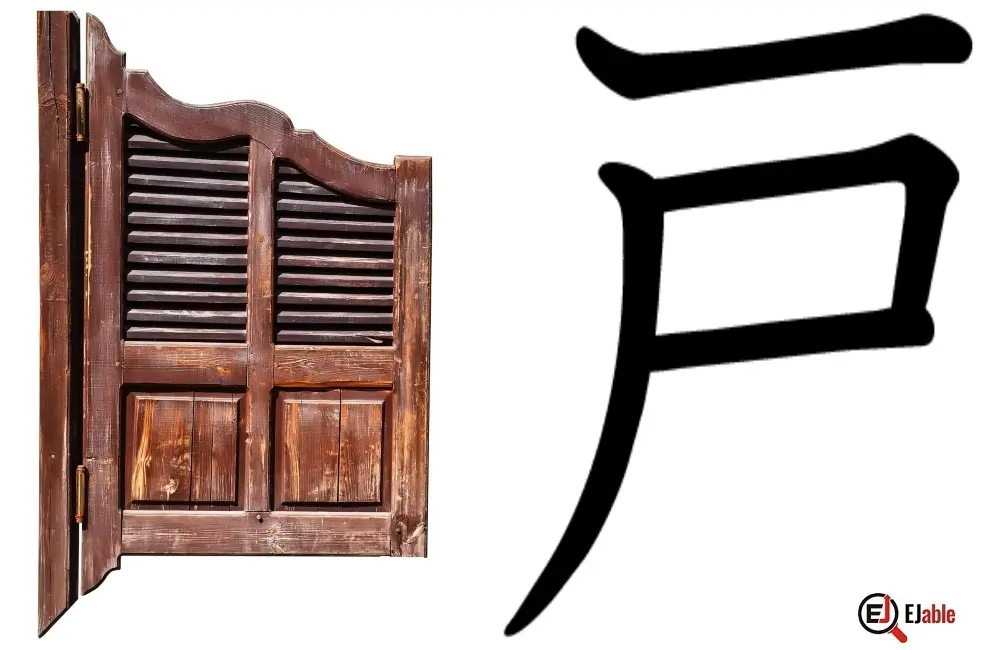
The Japanese kanji for “Door” is 戸.
Please note that The Kanji 戸 (と / to) primarily refers to doors, with a focus on single swinging or sliding doors typical of traditional Japanese architecture, but its use is not exclusively limited to single doors.
戸 symbolizes a door that is part of a household or building, emphasizing the entrance to a living space or a room. The concept of 戸 tends to be associated more with individual doors, including both traditional “Japanese sliding doors” (障子 / しょうじ / shōji or 襖 / ふすま / fusuma) and modern swinging doors.
Please note that the Kanji for “gate” for larger entrances is 門.
The kun’yomi (Japanese reading) pronunciation of the Kanji 戸 is “to” (と), and the on’yomi (Chinese reading) pronunciation of 戸 is “ko” (コ).
The Kanji 戸 is widely used in Japanese names and is a part of 4,415 names. However, in names, it is pronounced as E (え) or he (へ).
The Kanji 戸 is constructed with 4 strokes. 戸 is part of the JLPT N2 syllabus. In Japanese schools, this Kanji is taught in grade 2.
Origin of the Shape 戸
If we see the old shape of the Kanji 戸 in the Oracle Bone Script, it shows a single swinging door.
Let’s see the evolution of the shape of the door’s Kanji from ancient times to the current:
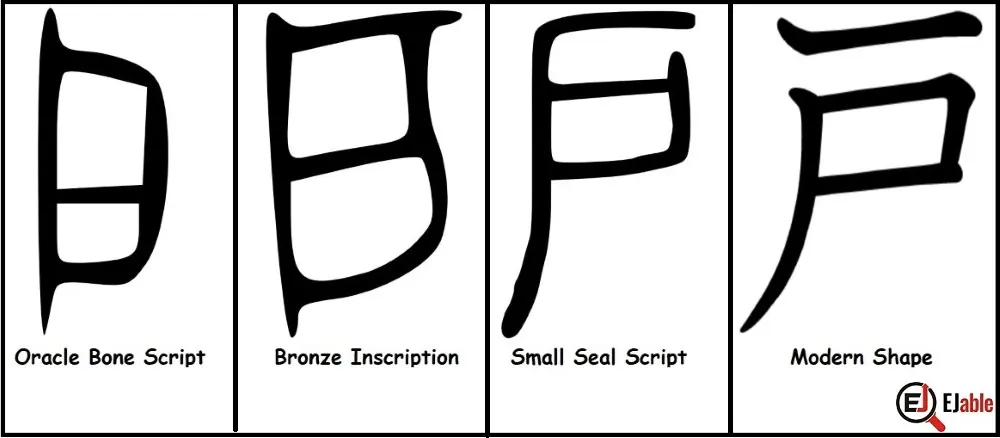
The above image shows the historical shape of 戸 in Oracle Bone Script, Bronze inscription, and small seal script, and how we write it in the present.
Mnemonic: How to Remember the Kanji for “Door” (戸)
The shape of the kanji of door 戸, which we use today, has changed greatly from its original shape. However, this Kanji is very easy to remember if we use the following illustration of a single swinging door as a mnemonic:
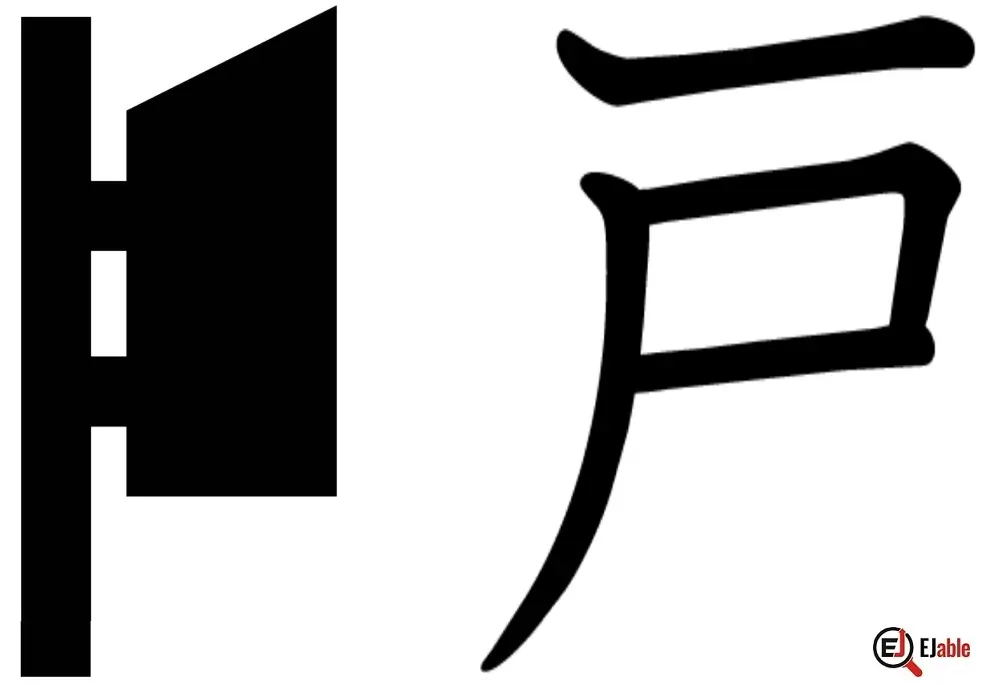
You may ask “how to explain the “horizontal” line at the top. Well, consider it as a roof, signifying a door under the roof of the house.
Stroke Order for the Kanji 戸
The following illustrations show the order of the 4 strokes to write the Kanji 戸:
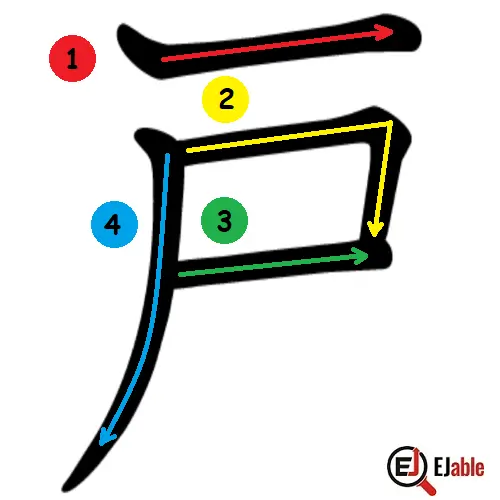
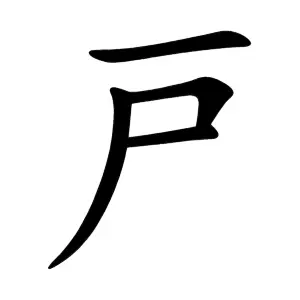
戸 as a Radical and Component in other Kanji Characters
The Kanji 戸 is used as a radical or component in 54 Kanji characters, out of which 14 are Jōyō (commonly used) Kanji.
In these other Kanji characters, 戸 reflects its association with “door” or aspects related to openings and households.
Examples of 戸 as a Radical or Component in Jōyō Kanji
Following are some examples of kanji where 戸 (door) appears as a radical or component:
- 所 (しょ / sho): Place; indicating a location or place, metaphorically a space one enters through a door.
- 戻 (もどき / modoki): Return; signifies returning, as if coming back through a door to an original position.
- 編 (へん / hen): Compile or edit; involves assembling parts, as if bringing them through a door to create a whole.
- 肩 (けん / ken): Shoulder; the structure of the character suggests bearing or carrying, not directly related to a door but incorporates 戸 in its formation.
- 涙 (るい / rui): Tears; the character reflects the concept of tears as if shedding them is like opening the door to emotions.
- 雇 (こ / ko): Employ; implies a relationship akin to inviting someone through a door for work.
- 房 (ぼう / bō): Room or chamber; directly relates to sections of a house, akin to rooms divided by doors.
- 顧 (こ / ko): Look back; metaphorically looking back as if through a door to the past.
- 扉 (ひ / hi): Hinged door; specifically denotes a type of door, emphasizing the entryway aspect.
- 啓 (けい / kei): Enlighten; conveys the idea of opening the door to knowledge or understanding.
- 偏 (へん / hen): Partial; the character structure suggests leaning towards one side as if a door is ajar.
- 炉 (ろ / ro): Hearth; symbolizes the hearth of a home, an essential part of the household, metaphorically tied to the concept of a door leading to warmth.
- 遍 (へん / hen): Everywhere; signifies spreading out in all directions, as if going through multiple doors to cover various places.
- 扇 (せん / sen): Fan; visually combines 戸 (door) and a feather, suggesting air movement similar to when a door is opened or as a tool that resembles a door’s shape.
These examples illustrate the application of 戸 as a component or radical with the concept related to doors, entrances, and thresholds in these Kanji characters.
Door’s Kanji in Compounded Words
The kanji for “door” 戸 is commonly used in the Japanese language and forms part of many compound words. There are 45 Japanese words that begin with the Kanji 戸, and it appears in 209 words.
Examples of Kanji 戸 in Compounded Kanji Characters
- 戸口 (とぐち / toguchi): Doorway; the entrance or exit of a door.
- 戸棚 (とだな / todana): Cupboard; a storage shelf or cabinet with doors.
- 戸外 (こがい / kogai): Outdoors; outside the doors of a house.
- 戸締り (とじまり / tojimari): Locking up; securing the doors of a house.
- 戸籍 (こせき / koseki): Family register; official documentation of household members.
- 戸惑い (とまどい / tomadoi): Perplexity; confusion as if one is at a closed door.
- 玄関戸 (げんかんど / genkando): Front door; the main entrance door of a house.
- 戸別 (こべつ / kobetsu): Door-to-door; visiting or surveying each household individually.
- 防音戸 (ぼうおんど / bōondo): Soundproof door; a door designed to block noise.
- 自動戸 (じどうど / jidōdo): Automatic door; a door that opens and closes automatically.
- 戸建て (こだて / kodate): Detached house; a standalone house, emphasizing individual doors.
- 戸限り (とかぎり / tokagiri): Limited to within the door; implying something is confined within a household.
- 戸数 (こすう / kosū): Number of households; a count of houses or apartments.
- 戸主 (こぬし / konushi): Head of the household; the person responsible for the household.
- 風呂戸 (ふろど / furodo): Bathroom door; the door leading to or part of a bathroom.
- 回転戸 (かいてんど / kaitendo) – Revolving door; a door that rotates around a central axis.
- 戸令 (これい / korei): A legal order or regulation regarding households.
- 納戸 (なんど / nando): Closet; a small storage room or space within a house.
The above examples show the use of the Kanji 戸 in compounded words related to doors or households. Why households? Well, a door separates a household from the outer world to make it a separate unit, and hence, in a way, the door represents a household or family.
Note: Check other Kanji characters on the page “How to Remember Kanji“.

A long-term ex-pat in Japan, Himanshu comes with an IT background in SAP consulting, IT Business Development, and then running the country operations of an IT consulting multinational. Himanshu is the co-founder and Managing Director of ReachExt K.K. and EJable.com. He is also an Advisory Board Member of a Silicon Valley AI/IoT startup.
